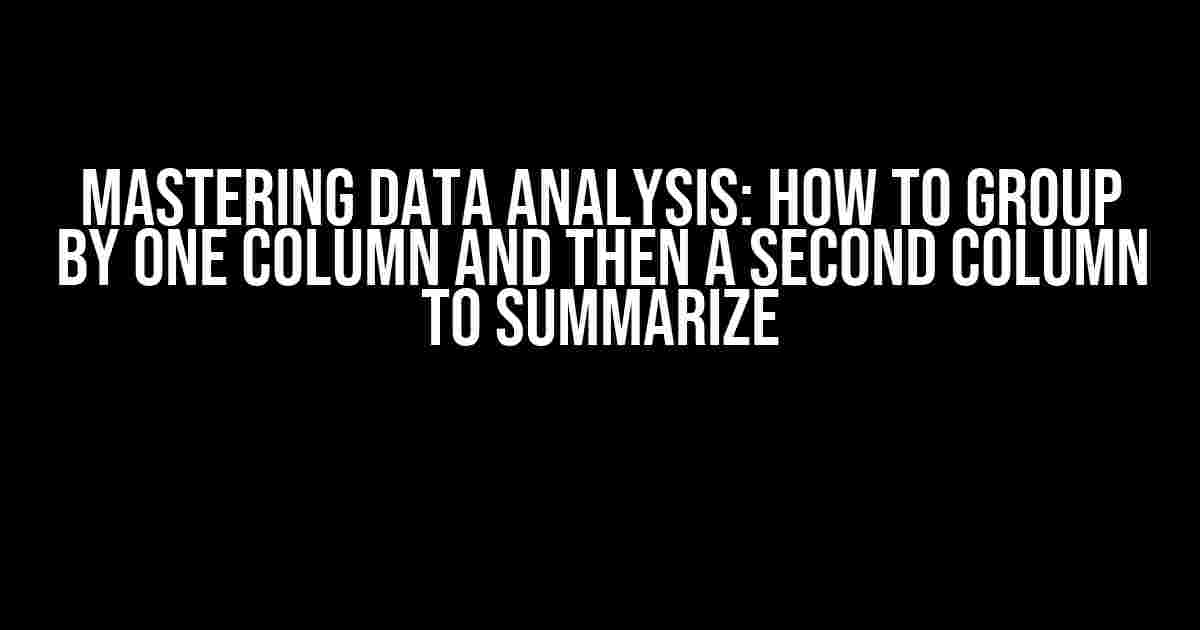Are you tired of staring at a sea of data, trying to make sense of it all? Do you struggle to identify patterns and trends in your datasets? Fear not, dear analyst, for we’re about to dive into one of the most powerful tools in the data analysis arsenal: grouping by one column and then a second column to summarize. Buckle up, because by the end of this article, you’ll be a master of data manipulation!
What is Grouping by One Column and Then a Second Column?
In essence, grouping by one column and then a second column is a process of categorizing data into groups based on the unique values in one column, and then further categorizing those groups based on the unique values in another column. This allows you to summarize and analyze data at multiple levels of granularity, revealing insights that would be impossible to uncover with a single-level grouping.
Why is Grouping by One Column and Then a Second Column Important?
- Hierarchical Analysis**: By grouping data at multiple levels, you can perform hierarchical analysis, examining relationships between variables at different levels of granularity.
- Pattern Identification**: Grouping by two columns helps identify patterns and trends that might be obscured by a single-level grouping.
- Data Visualization**: Multi-level grouping enables creation of detailed and informative data visualizations, such as nested bar charts and heatmaps.
- Business Insights**: This technique is particularly useful in business analysis, where it can help identify customer segments, product bundles, and geographic trends.
Tools and Techniques for Grouping by One Column and Then a Second Column
Luckily, you don’t need to be a data wizard to perform this type of analysis. Most data analysis tools and programming languages provide built-in functions or libraries that make it easy to group data by multiple columns.
Microsoft Excel
In Excel, you can use the `GROUPBY` function in combination with the `SUMIFS` function to group data by one column and then a second column. Here’s an example:
=GROUPBY(A:A, B:B, SUMIFS(C:C, A:A, A2, B:B, B2))Pandas in Python
In Python, the Pandas library provides the `groupby` method, which can be used to group data by multiple columns. Here’s an example:
import pandas as pd
df.groupby(['column1', 'column2']).sum()SQL
In SQL, you can use the `GROUP BY` clause in combination with the `SUM` function to achieve the same result. Here’s an example:
SELECT
column1,
column2,
SUM(column3)
FROM
table
GROUP BY
column1,
column2Step-by-Step Guide to Grouping by One Column and Then a Second Column
Now that we’ve covered the basics, let’s dive into a step-by-step guide on how to group by one column and then a second column using a sample dataset.
Dataset
Suppose we have a dataset containing sales data for different regions, products, and time periods. Our goal is to group the data by region, and then by product, to summarize the total sales for each product in each region.
| Region | Product | Time Period | Sales |
|---|---|---|---|
| North | A | Q1 | 100 |
| North | B | Q1 | 200 |
| North | A | Q2 | 150 |
| South | C | Q1 | 300 |
| South | D | Q1 | 250 |
| East | E | Q2 | 400 |
| East | F | Q2 | 350 |
Step 1: Import and Clean the Data
First, we need to import the dataset into our preferred data analysis tool or programming language. Then, we need to ensure the data is clean and free of errors.
# Import the dataset into Pandas
import pandas as pd
df = pd.read_csv('sales_data.csv')
# Check for missing values and handle them accordingly
df.dropna(inplace=True)Step 2: Group the Data by One Column (Region)
Next, we need to group the data by the first column, which is the region.
# Group the data by region
region_groups = df.groupby('Region')Step 3: Group the Data by a Second Column (Product)
Now, we need to group the data by the second column, which is the product, within each region.
# Group the data by product within each region
product_groups = region_groups.groupby('Product')Step 4: Summarize the Data
Finally, we need to summarize the data by calculating the total sales for each product in each region.
# Calculate the total sales for each product in each region
sales_summary = product_groups['Sales'].sum()
print(sales_summary)Result
The resulting summary will look something like this:
| Region | Product | Total Sales |
|---|---|---|
| North | A | 250 |
| North | B | 200 |
| South | C | 300 |
| South | D | 250 |
| East | E | 400 |
| East | F | 350 |
Voilà! We’ve successfully grouped the data by one column and then a second column to summarize the total sales for each product in each region.
Conclusion
Grouping by one column and then a second column is a powerful technique in data analysis that can help you uncover hidden patterns and trends in your data. By following the steps outlined in this article, you’ll be well on your way to becoming a data analysis master. Remember to practice, practice, practice, and soon you’ll be grouping like a pro!
Happy analyzing!
Frequently Asked Question
Are you tired of sifting through your data, trying to make sense of it all? Do you want to learn how to group by one column and then a second column to summarize your data with ease? Well, you’re in luck because we’ve got the answers to your most pressing questions!
How do I group by one column and then a second column in pandas?
To group by one column and then a second column in pandas, you can use the groupby function with multiple columns. For example, if you have a DataFrame df and you want to group by the columns ‘column1’ and ‘column2’, you can use df.groupby([‘column1’, ‘column2’]). This will create a hierarchical index with ‘column1’ as the top level and ‘column2’ as the second level. From there, you can use aggregation functions like sum, mean, or count to summarize your data.
What is the difference between groupby and pivot_table in pandas?
While both groupby and pivot_table can be used to summarize data, the key difference lies in their output. Groupby returns a DataFrameGroupBy object, which can be further manipulated using aggregation functions. Pivot_table, on the other hand, returns a DataFrame with a new index and columns based on the values in the original DataFrame. Pivot_table is particularly useful when you want to create a cross-tabulation of your data.
How do I group by multiple columns and then calculate the mean of another column?
To group by multiple columns and then calculate the mean of another column, you can use the groupby function followed by the mean function. For example, if you want to group by the columns ‘column1’ and ‘column2’ and then calculate the mean of ‘column3’, you can use df.groupby([‘column1’, ‘column2’])[‘column3’].mean(). This will return a new DataFrame with the mean values for each group.
Can I use groupby to summarize data based on a condition?
Yes, you can use groupby to summarize data based on a condition by applying the condition to the data before grouping. For example, if you want to group by ‘column1’ and then calculate the mean of ‘column2’ only for rows where ‘column3’ is greater than 0, you can use df[df[‘column3’] > 0].groupby(‘column1’)[‘column2’].mean(). This will return a new DataFrame with the mean values for each group, based on the filtered data.
How do I reset the index after grouping by multiple columns?
To reset the index after grouping by multiple columns, you can use the reset_index function. For example, if you have a DataFrameGroupBy object called group, you can use group.reset_index() to reset the index and return a new DataFrame with a default integer index. This can be useful when you want to perform further analysis or visualizations on the summarized data.





